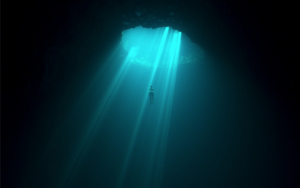THE DEEPEST BREATH: 3 ½ STARS. “beautiful and haunting underwater photography.”
 As extreme sports go, few entail the danger of free-diving. Often immersed hundreds of meters under the water, with no breathing apparatus, divers rely on mental and physical rigor to ensure success. One wrong move, a few seconds extra under the extraordinary pressure of the water, and all can be lost.
As extreme sports go, few entail the danger of free-diving. Often immersed hundreds of meters under the water, with no breathing apparatus, divers rely on mental and physical rigor to ensure success. One wrong move, a few seconds extra under the extraordinary pressure of the water, and all can be lost.
A new documentary, “The Deepest Breath,” now playing in theatres before moving to Netflix next week, is an up-close-and-personal look at the sport and the people who risk their lives to practice it.
Director Laura McGann assembles a study of the sport, vividly utilizing underwater photography and interviews with practitioners to provide context, and set the stage for the film’s main story, the story of Irish adventurer Stephen Keenan and Italian freediving champion Alessia Zecchini.
Determined to set a world’s record, Zecchini sets her sights on “the last quiet place on Earth,” the Blue Hole Arch, a claustrophobic 85-foot-long tunnel 184 feet below the Red Sea in Egypt. The treacherous tunnel has claimed at least 100 divers, so to aid in her dive, Keenan will act as her safety diver. His job is to track her underwater movements in case she gets lost or blacks out due to the lack of breath.
No spoilers here, but the dive does not go as planned.
With beautiful and often haunting underwater photography, director McGann gives “The Deepest Breath” a you-are-there feeling. The starkness of the dive footage effectively emphasizes the singularity of the sport; the self-reliance and mental preparation it takes to take the plunge.
The film is slightly less successful in the telling of its story. The first half of the doc is filled with choppy storytelling, archival interviews and digressions on behalf of its cast of characters. It makes for an uneven experience, but the immersive nature of the filmmaking in the ethereal underwater scenes calms any rough waters in the storytelling.
“The Deepest Breath” may not be completely satisfying account of why people risk their lives in this extreme sport, but it is a compelling visual record of those who do.
